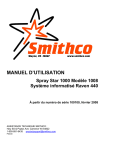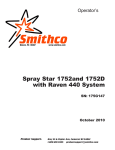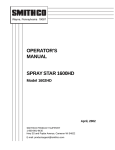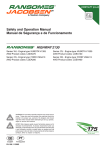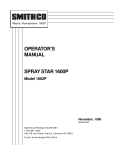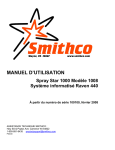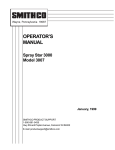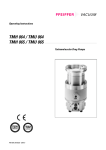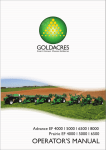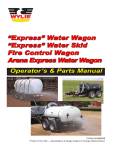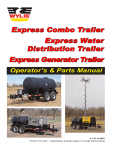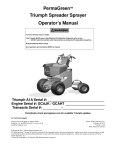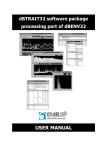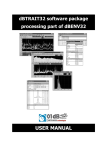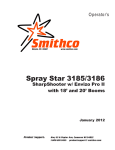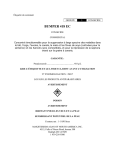Download Spray Star 1000
Transcript
Spray Star 1000 with Manual 3-Way Valve SN: 100413 December 2008 CONTENTS Introduction Introduction ................................................................................. 1-9 Introduction .................................................................................. 1 Symbols ................................................................................... 2-3 Safe Practices ............................................................................. 4 Safe Spraying Practices .............................................................. 5 Operation Specifications .............................................................................. 6 Optional Equipment ..................................................................... 6 Setup .......................................................................................... 7 Controls & Instruments ............................................................. 8-9 Operation .................................................................................. 10-14 Schematics Spraying Procedure ................................................................. 15-21 Spraying Introduction ................................................................. 15 Turf Management ....................................................................... 15 Hose & Handgun Spraying ......................................................... 16 Nozzles ................................................................................ 16-17 Spraying Procedures Calibration Introduction .............................................................. 18 The Nozzle Chart Method ..................................................... 19-20 The “128” Methood ................................................................ 20-21 Nozzle Charts ............................................................................ 22-27 Nozzle Performance Chart #1 .................................................... 22 Nozzle Performance Chart #2 .................................................... 23 Nozzle Charts Nozzle Performance Chart #3 .................................................... 24 Nozzle Performance Chart #4 .................................................... 25 Nozzle Performance Chart #5 .................................................... 26 Nozzle Performance Chart #6 .................................................... 27 Reference .................................................................................. 28-29 Abbreviations and Conversions .................................................. 28 Reference Declaration of Conformity ........................................................... 29 Warranty ........................................................... Inside Back Cover Thank you for purchasing a Smithco product. Read this manual and all other manuals pertaining to the Spray Star 1000 carefully as they have safety, operating, assembly and maintenance instructions. Failure to do so could result in personal injury or equipment damage. Keep manuals in a safe place after operator and maintenance personnel have read them. Right and left sides are from the operator’s seat, facing forward. All Smithco machines have a Serial Number and Model Number. Both numbers are needed when ordering parts. The serial number plate on the Spray Star 1000 is located on the right main frame, in front of the oil tank. Refer to engine manual for placement of engine serial number. For easy access record your Serial and Model numbers here. Information needed when ordering replacement parts: 1. Model Number of machine. 2. Serial Number of machine. 3. Name and Part Number of part. 4. Quantity of parts. 1 Introduction INTRODUCTION Introduction SYMBOLS 2 Read Operator’s Manual Electrical Power No Electrical Power Engine - Stop Engine - Start Engine - Run Engine Oil Temperature Light Water Temperature RPM Gasoline Diesel Glow Plug - On Glow Plug - Off Glow Plug Hour Meter Hour Meter Hand Throttle Choke - Closed Choke - Open Park Brake Park Brake Release Hydraulic Oil Level Fuse H R Up/Down Arrow Down/Lower Up/Raise No Smoking Moving Parts Manual Operation Pinch Point Step Hot Surface Hydraulic Fluid Penetration Lift Arm Tractor Engage Disengage PTO Ground Speed Fast Slow High Reverse L N Low Neutral F Introduction SYMBOLS Forward Warning Danger Caution 3 SAFE PRACTICES Introduction 1. It is your responsibility to read this manual and all publications associated with this machine. 2. Never allow anyone to operate or service the machine or its optional equipment without proper training and instructions. Never allow minors to operate any equipment. 3. Learn the proper use of the machine, the location and purpose of all the controls and gauges before you operate the equipment. Working with unfamiliar equipment can lead to accidents. 4. Wear all the necessary protective clothing and personal safety devises to protect your head, eyes, ears, hands and feet. Operate the machine only in daylight or in good artificial light. 5. Inspect the area where the equipment will be used. Pick up all debris you can find before operating. Beware of overhead obstructions and underground obstacles. Stay alert for hidden hazards. 6. Never operate equipment that is not in perfect working order or without decals, guards, shields, or other protective devices in place. 7. Never disconnect or bypass any switch. 8. Carbon monoxide in the exhaust fumes can be fatal when inhaled, never operate a machine without proper ventilation. 9. Fuel is highly flammable, handle with care. 10. Keep engine clean. Allow the engine to cool before storing and always remove the ignition key. 11. Disengage all drives and set park brake before starting the engine. 12. Never use your hands to search for oil leaks. Hydraulic fluid under pressure can penetrate the skin and cause serious injury. 13. This machine demands your attention. To prevent loss of control or tipping of the vehicle: A. Use extra caution in backing up the vehicle. Ensure area is clear. B. Do not stop or start suddenly on any slope. C. Reduce speed on slopes and in sharp turns. Use caution when changing directions on slopes. D. Stay alert for holes in the terrain and other hidden hazards. 14. Before leaving operator’s position: A. Disengage all drives. B. Set park brake. C. Shut engine off and remove the ignition key. D. If engine has to run to perform any maintenance keep hands, feet, clothing and all other parts of body away from moving parts. 15. Keep hands, feet and clothing away from moving parts. Wait for all movement to stop before you clean, adjust or service the machine. 16. Keep the area of operation clear of all bystanders. 17. Never carry passengers. 18. Stop engine before making repairs/adjustments or checking/adding oil to the crankcase. 19. Use parts and materials supplied by Smithco only. Do not modify any function or part. 20. Use caution when booms are down as they extend out beyond the center line of the machine. 21. The tank is a confined space, take precaution. These machines are intended for professional maintenance on golf courses, sports turf, and any other area maintained turf and related trails, paths and lots. No guarantee as to the suitability for any task is expressed or implied. 4 Persons engaged in the handling, preparation or application of chemicals must follow accepted practices to insure the safety of themselves and others, 1. WEAR protective clothing including: gloves, hat, respirator, eye protection and skin covering suitable for protection from chemicals being used. 2. BATHE thoroughly after any exposure to chemicals, giving particular attention to eyes, nose, ears and mouth. 3. CLEAN equipment and materials in accordance with employer, municipal and state regulations. Use only approved areas and drains. 4. DISPOSE of chemicals and rinse solutions by approved and legal means. 5. PROVIDE methods and materials for operators to wash eyes and hands immediately during the spraying process. 6. PROVIDE methods and materials for control, safe dilution and neutralization of chemical spills during preparation, spraying, transporting and cleanup. 7. Always check and follow the directions and safety warnings of the chemicals to be used. 8. Secure the discharge lines before starting the pump. An unsecured discharge line may whip. 9. Periodically inspect the pump and the system components. 10. Check hoses for weak or worn condition before each use. Make certain that all connections are tight and secure. 11. Do not operate unit with leaks, frayed, kinked hoses or tubing. Repair or replace immediately. 12. Use only pipe, hose and fittings rated for maximum pressure or pressure at which pressure relief valve is set at. When replacing pipe, hose or fittings, use new product. 13. Do not operate a gasoline engine in an enclosed area. Be sure the area is well ventilated. 14. Do not use these pumps for pumping water or other liquids for human or animal consumption. 15. Do not pump flammable or explosive fluids such as gasoline, fuel oil, kerosene, etc. Do not use in explosive atmospheres. The pump should be used only with liquids compatible with the pump component materials. 16. Be sure all exposed moving parts are guarded and that all coupling devices are securely attached before applying power. 17. Before servicing, disconnect all power, make sure all pressure in the system is relieved, drain all liquids from the system and flush. 18. Protect pump from freezing conditions by draining liquid and pumping rust inhibiting antifreeze solution through the system, coating the pump interior. 5 Introduction SAFE SPRAYING PRACTICES SPECIFICATIONS Introduction WEIGHTS AND DIMENSIONS Length Width Width With Boom Open Height Wheel Base Weight Empty Weight Full 112" (285 cm) 70" (178 cm) 180" (457 cm) 48" (122 cm) 53" (135 cm) 1200 lbs (544 kg) 2200 lbs (998 kg) SOUND LEVEL (DB) At ear level At 3 ft (0.914 m) At 30 ft (9.14 m) 88 dB 84 dB 72 dB ENGINE Make Model# Type / Spec# Horsepower Fuel Cooling System Lubrication System Alternator Kohler Command CH25S PA 68673 25 hp (18 kW) Unleaded 87 Octane Gasoline Minimum Air Cooled Full Pressure 25 amp WHEELS & TIRE Front: Two 20 x 10.00 x 10 NHS Multi-Rib; 20 psi (1.4 bar) Rear: Two 24 x 12.00 x 12 NHS Multi-Trac; 20 psi (1.4 bar) SPEED Forward Speed Reverse Speed 0-8 m.p.h. (0-12.8 kph) 0-3 m.p.h. (0-4.8 kph) BATTERY BCI Group Cold Cranking Amps Ground Terminal Polarity Maximum Length Maximum Width Maximum Height Automotive type 24F - 12 volt Size 24 575 minimum Negative (-) 10.25" (26 cm) 6.88" (17 cm) 10" (25 cm) FLUID CAPACITY Crankcase Oil Fuel Hydraulic Fluid Grade of Hydraulic Fluid See Engine Manual 7 gallon (26.5 liters) 5 gallon (19 liters) SAE 10W-40 API Service SJ or higher Motor Oil OPTIONAL EQUIPMENT 10-417 10-419 10-103 10-160 10-301 10-365 10-377 16-129 16-906 6 Chemical Cleanload Safe Fill System 1002 203 Spray System Fresh Water Tank 1008 440 Spray System Electric Actuator Lift Kit 1010 3-Way Manual System 15' Stainless Steel Boom - manual 10-378 Foam Marker 15' Terrain Following Boom 15-622 Weather Canopy Water Meter KIt (gallons) 10-370 Water Meter Kit (liters) Hose Reel Mounting Kit 33-541 Triple Nozzle Kit for 15ft/5m 9 nozzle Boom Manual Rewind Hose Reel, 200-foot/61-meter capacity Electric Rewind Hose Reel, 200-foot/61-meter capacity The Spray Star 1000 arrives from Smithco setup and ready for service. Depending on freight conditions the battery may have to be installed. The spray system is normally shipped attached to the 1000 Prime Mover. If a spray system is to be fitted to a Prime Mover by a dealer or end user, assemble and attach the components in accordance with the parts drawings in the Spray Star 1000 Parts/Service Manual. 1. Check the tire pressure. The front and rear tires are 20 psi (1.4 bar). 2. Battery is located under the seat. This is a negative grounding system. Connecting battery cables to the wrong post could result in personal injury and/or damage to the electrical system. Make sure battery and cables do not interfere or rub on any moving part. Connect red positive (+) cable (A) to battery first. When disconnecting remove black negative (-) cable (B) first. 3. Check hydraulic fluid level in tank located on the left side of the seat. Remove cap and add SAE 10W-40 API Service SJ or higher motor oil if necessary. Fluid level should be about 2-21/2" (5-6.4 cm) from the top of the tank when cold. DO NOT OVERFILL. 4. Fill fuel tank, located on the right side, with Unleaded 87 Octane gasoline (minimum). Fuel is flammable, caution must be used when storing or handling it. Do not fill fuel tank while engine is running or an enclosed area, fumes are explosive and dangerous to inhale. DO NOT SMOKE while filling the fuel tank. DO NOT OVERFILL. 5. Machine should be greased before starting, refer to Spray Star 1000 Parts/Service Manual for location. 6. Attach the Spray Boom and any other Optional Equipment to the Prime Mover, in accordance with instructions in the Spray Star 1000 Parts/Service Manual. The nozzles must be the correct distance above the turf as described in Turf Spraying Guide. The spray boom must operate properly and the outer sections must break away safely if an object is struck by them, they must then return to normal operation position. 7. Be sure to double check boom heights, nozzle spacing and displacement before spraying. 8. Machine is shipped with windshield washer fluid in Spray System to prevent freezing. Flush system completely with clear water. Fill tank with water and retighten the four bolts used to hold the tank in place. 9. Read operating instructions before starting. Never allow pump to run dry! The valve on the suction side of the pump (between the pump and tank) must be fully open whenever the pump is operated. 7 Introduction SETUP CONTROLS $ INSTRUCMENTS Introduction A. Hour Meter - The hour meter indicates hours of machine operation. It operates only when the ignition switch is on. B. Speedometer - The Speedometer indicates ground speed of the vehicle in miles per hour and kilometers per hour. C. Oil Light - The oil light should come on when the ignition is on without the engine running and go out when the engine is running. The oil light will light when the oil pressure is low. If oil light should come on, shut engine off immediately and find the cause. D. Ignition Switch - The ignition switch has three positions: Off - Run - Start. E. Tilt Steering - Hold lever down and adjust steering wheel to desired position and release lever. F. Buzzer - The buzzer sounds if the pump is running dry. G. Lights - This rocker switch turns lights on by pushing on the top and off by pushing on the bottom. H. Spray Pump - This rocker switch turns the spray pump on by pushing on the top and off by pushing on the bottom. I. Left Boom Switch - This rocker switch lifts and lowers the left boom. J. Right Boom Switch - This rocker switch lifts and lowers the right boom. K. Choke - The choke is used in starting the engine. Pull choke out to close choke plate when starting a cold engine. Push in when engine starts. A warm engine may not require "choking" to start. L. Hand Throttle - The hand throttle is used to regulate engine speed. M. Park Brake - The park brake is only a parking brake. Pull back to release, push forward to apply. Some adjustment can be made by turning the knob clockwise to tighten and counter clockwise to loosen. 8 Introduction CONTROLS & INSTRUMENTS N. Spray Boss Control - Engages and disengages speed boss. Forward is engage and all the way back is disengage. When the lever is engaged it sets a stop for the accelerator. The accelerator pedal must be used to maintain this speed. To adjust speed use the knob on the end of the lever, counter clockwise increases speed and clockwise decreases speed. Disengage the lever and you will have full accelerator pedal range. O. Cup Holder - Holds standard cup. P. Master Boom Switch - is used to override the master switch on the computer console of the spray systems. Q. Reverse Pedal - This pedal controls ground speed in the reverse direction. R. Accelerator Pedal - This pedal controls ground speed. Press pedal to increase speed. Varying the amount of movement of the pedal will vary the ground speed. MASTER BOOM SWITCH The master boom switch (P), located on the left floorboard is used to override the master switch on the computer console of the spray systems. By pushing down it will turn on/off the booms. For the Raven 440 System the Master Switch on the computer must be off for the master boom control switch to work. 9 OPERATION Before operating the Spray Star 1000, become familiar with all controls and functions. Also complete all maintenance requirements and read all safety warnings. Knowing the Spray Star 1000 thoroughly, how it operates, and by doing the prescribed maintenance steps, you can expect trouble free operation for years to come. SAFETY Safety needs to always be the concern of an operator of a moving vehicle or any machine with moving parts. 1. Keep all shields and guards in place. Operation 2. Keep the parking brake engaged any time the operator is away from the vehicle or whenever service is performed. 3. Always wear the necessary protective clothing and equipment. 4. Turn engine off when refueling or performing maintenance not specifically requiring engine power. DAILY CHECKLIST 1. Check the engine oil level. Add as needed. DO NOT OVERFILL. Refer to engine owner's manual for oil grade and procedure. 2. Tire pressure should be 20 psi (1.4 bar) maximum. 3. Inspect the electrical system and battery cables for loose connections or frayed wiring. Replace any faulty equipment or tighten if loose. 4. Check hardware for loose or missing nuts, bolts, screws, etc., and tighten or replace as needed. 5. Inspect hydraulic lines for damage or leaks. Never use hands to inspect for leaks. 6. Check the hydraulic fluid level. The hydraulic fluid tank is located on the left side of the machine. The fluid level should be 2"-2½" (5 - 6.4 cm) from the top of the tank when cold. Use only SAE 10W-40 API Service SJ or higher Motor Oil. 7. Inspect the steering, throttle and shift linkages for good hookups and clear travel. 8. Check controls for smooth, proper working operation. Lubricate as needed. 9. Check park brake adjustments. Adjust as required. 10. Check anti-vibration mounts on engine frame. STARTING THE ENGINE 1. Make sure the fuel flow valve is ‘On’. It is located on the fuel tank. 2. The ignition switch is located on the dashboard. Insert the key (A) and turn clockwise until the engine starts (C). Release the key and it will return to the run position (B). Use the choke and hand throttle as necessary. 3. Allow engine to idle and warm up before selecting direction of travel. STOPPING THE ENGINE If the engine has been running under high power, let it run at slow idle speed a few minutes to cool the engine down, before turning the ignition switch to the OFF position. 1. Disengage spray pump. 2. Move the throttle lever to “slow” and turn ignition key to the “off” position. 3. Remove the ignition key and engage the park brake. Never leave the vehicle unattended with the engine running. Always bring the vehicle to a complete stop, engage park brake, turn key off and remove key. 10 OPERATION Before using the Spray Star, the operator and spray technician must familiarize themselves with all of the information on chemical spraying contained in the Turf Spray Guide. TOWING UNIT When it is necessary to move the Spray Star 1000 without the engine running, the bypass valve built into hydrostatic pump must be "open" by turning it counterclockwise. The valve is located on the bottom of the pump. An "open" valve allows fluid to pass through the wheels freely. When normal driven operation is desired, valve should be "closed" by turning it clockwise. Failure to "close" the valve with engine running means no power to wheels. HILLSIDE OPERATION Do NOT stop or start suddenly on any slope. Be especially cautious when changing direction. Do NOT operate on slopes greater than 20°. BATTERY Batteries normally produce explosive gases which can cause personal injury. Do not allow flames, sparks or any ignited object to come near the battery. When charging or working near battery, always shield your eyes and always provide proper ventilation. Battery cable should be disconnected before using “Fast Charge”. Charge battery at 15 amps for 10 minutes or 7 amps for 30 minutes. Do not exceed the recommended charging rate. If electrolyte starts boiling over, decrease charging. Always remove grounded (-) battery clamp first and replace it last. Avoid hazards by: 1. Filling batteries in well-ventilated areas. 2. Wear eye protection and rubber gloves. 3. Avoid breathing fumes when electrolyte is added. 4. Avoid spilling or dripping electrolyte. Battery Electrolyte is an acidic solution and should be handled with care. If electrolyte is splashed on any part of your body, flush all contact areas immediately with liberal amounts of water. Get medical attention immediately. JUMP STARTING Use of booster battery and jumper cables. Particular care should be used when connecting a booster battery. Use proper polarity in order to prevent sparks. To jump start (negative grounded battery): 1. Shield eyes. 2. Connect ends of one cable to positive (+) terminals of each battery, first (A) then (B). 3. Connect one end of other cable to negative (-) terminal of "good" battery (C). 4. Connect other end of cable (D) to engine block on unit being started (NOT to negative (-) terminal of battery) To prevent damage to other electrical components on unit being started, make certain that engine is at idle speed before disconnecting jumper cables. 11 Operation All testing and calibrating of sprayers is to be done with water, not chemicals. This insures the safety to all involved in performing the calibration operation. Only after all calibration procedures are completed should chemical be added to the sprayer. OPERATION SPRAY TANK AGITATION The gate valve on the suction side of the pump, between the tank and the pump must be open before pump is engaged. Close this valve only when necessary to clean the filter with spray material in the spray tank. Front View Back View Operation A. Main Pressure Adjustment - Turn to adjust desired pressure on the pressure gauge. B. Main Boom Lever - Allows pressure to enter the system. Down is engage, up is disengage. C. Pressure Gauge - indicates in PSI when spraying. D. Boom Levers - Three levers that turn on each boom section, right - center - left. E. Boom Pressure Adjustment - Three adjustment knobs that adjust the pressure for each boom. They match the boom lever that is above them. To raise pressure close knob. To lower pressure open knob. SPRAYER VALVE SETTING 1. Engage the main boom lever (B) to allow pressure into the system. 2. Flip all boom levers (D) up to engage. 3. Adjust the main pressure (A) to show desired pressure on pressure gauge (C). 4. Doing one boom section at a time, Push the first boom lever (D) down or shut off. If pressure gauge drops in psi close the boom pressure knob (E) below boom lever. If pressure rises open boom pressure knob. Objective is to have equalized pressure when the boom lever is flipped. Do this with all three boom levers. 5. When pressure is equalized an all three booms the valve has been configured for spraying. 12 OPERATION If your Spray Star is fitted with a hose reel, there is a third ball valve on the discharge system to supply material to the hose reel. Nozzle Diameter 1 /8" /8" 1 /8" 5 /32" 5 /32" 5 /32" 3 /16" 3 /16" 3 /16" 1 Input to Agitator in gpm Input to Agitator in L/min 1.9 2.7 3.8 2.8 4.2 5.5 3.6 5.6 7.9 7.2 10.2 14.4 10.6 15.9 20.8 13.6 21.2 29.9 Agitator Agitator Pressure Pressure in psi in bar 25 50 100 25 50 100 25 50 100 1.7 3.4 6.9 1.7 3.4 6.9 1.7 33.4 6.9 Agitator Output in gpm Agitator Output in L/min 6.3 10.0 15.0 7.6 12.2 17.5 9.1 14.3 18.7 23.8 37.9 56.8 28.8 46.2 66.2 34.4 54.1 70.8 Operation The Quadrajet agitation system operates with four venturi jets in the tank bottom. These jets have replaceable orifice discs which discharge the following amounts of spay material. You can change orifice disc sizes to enhance spray system performance. Smaller discs reduce amount of agitation (desirable in some foaming materials) and make more dischargeable liquid available for nozzles. Larger (or none) discs increase amount of agitation and make less dischargeable liquid available for nozzles. SPRAY OPERATION (After Proper Setup and Calibration) 1. Add 1/2 the amount of water required for the spray operation to tank using air gap filler. 2. Start engine, set engine speed below 2000 RPM, and engage pump after taking all previously described safety and operation precautions. 3. Open agitator valve. 4. Add chemicals (taking all precautions described in this manual and by the chemical manufacturer). a. Liquids may be poured directly into tank. b. Wettable powder chemicals must be pre-mixed with water in a container to form a slurry. The mixture is then added to the tank through the fillwell strainer. c. Chemical in soluble packs are place into the fillwell strainer basket and dissolved by adding water through the basket. The balance of the water required for the spray operation is added to the tank through the fillwell strainer, using the air gap filler. This will wash any undissolved chemical into the tank. 5. Transport to sprayer site with and agitator operating. 6. Set Engine speed between 2000-3200 RPM. 7. (Optional) Engage ground speed control. 8. Obtain desired spraying speed before activating spray with switches on spray control console. Review the capacity of nozzles being used. Total capacity of all nozzles plus agitation system must not exceed pumping system capabilities refer to Spraying Procedure section of this manual. FLUSH PUMP AFTER USE Shut-Off 20GPM 40GPM 60GPM 80GPM 100GPM 120psi 100psi 80psi 60psi 30psi 10psi 100psi 95psi 76psi 52psi 26psi 5psi 80psi 75psi 62psi 45psi 21psi 60psi 55psi 40psi 25psi 5psi To determine the correct performance data for your application, first shut off all flow on discharge side of pump and detemine the shut-off pressure at the pump. Use this Shut-Off pressure to determine which line of data applies. 13 SPRAY OPERATION One of the most common causes for faulty-pump performance is corrosion inside the pump. Flush the pump and entire system with a solution that will chemically neutralize the liquid pumped. Mix according to manufacturer’s directions. This will dissolve most residue remaining in the pump, leaving the inside of the pump clean for the next use. Operation TO PREVENT CORROSION After cleaning the pump as directed, flush it with a permanent type automobile antifreeze (Prestone, Zerex, etc.) containing a rust inhibitor. Use a 50% solution that is, half antifreeze and half water. Then coat the interior of the pump with a substance which will prevent corrosion such as Fluid Film or WD40. If unit will not be used for an extended period of time, disconnect hoses into and out of the pump, seal openings to the pump with caps or tape. Dispose of fluids according to all federal, state and local regulations. All chemicals and chemical residue must be removed after each use. Dispose of fluids and residue according to all federal, state and local regulations. SPRAYER CLEANING Empty tank and clean unit thoroughly after each use following these instructions: 1. Remove coupling and rinse inside of tank thoroughly with clean water, replace coupling. 2. Fill tank ten percent full with clean water, start pump and discharge water through spray hose or spray boom (with nozzles removed), until empty. 3. Remove drain coupling again and rinse tank interior thoroughly. 4. Rinse exterior of sprayer thoroughly with clean water. MANUAL HOSE REEL Located at the back of the Spray Star behind the tank. Open the ball valve located near the pump to allow fluid to flow into the hose reel. Place the lockout pin in the unlocked position by pulling and turning it half a turn, this will allow you to pull out additional hose or to use the handle and wind up the hose. To prevent movement during transport or storage place the lockout pin in the locked position. ELECTRIC HOSE REEL Located at the back of the Spray Star behind the tank. Open the ball valve located near the pump to allow fluid to flow into the hose reel. To unwind hose just pull on the hose to get the desired amount. To wind up the hose make sure the toggle switch is in the ON position, push the momentary push button switch until you have reeled in the amount of hose desire. Turn off the safety switch when not in use. FOAM MARKER The control box is located to the right of the control panel. Use lever on compressor to designate which boom is to be used to dispense foam. Use dial located on the foamer to adjust pressure for the amount of foam that will be dispensed. Switch on compressor also turns foamer on or off. 14 SPRAYING INTRODUCTION This section is intended to offer practical guidelines for the distribution of liquid chemicals over an area of turfgrass such as golf courses, park land, school grounds and lawns.Smithco makes no representation as to the suitability of any technique or product for any particular situation. This section is suitable for self-propelled spray vehicles or sprayers mounted onto vehicles. Boom Spraying is the most effective, accurate and efficient method of applying chemicals to large turf areas. It may be done by means of: • A dedicated spray vehicle • A sprayer mounted upon a utility vehicle Sprayers are typically equipped with wide spray booms. Generally these booms are between 15 feet (4.5 m) and 20 feet (6 m) in width. They are divided into three sections, with hinges that permit the long outer sections to automatically move out of the way and reset if an obstacle such as a tree or fence is in you path. To minimize the chance for missed areas or double application use a device to mark the outside boundaries of each spray swath. Foam markers and dye markers are advisable. TURF MANAGEMENT Turf management chemicals are made for four general purposes: 1. Fungicides: Prevent or cure fungus on turfgrass. They are made in 2 general types: 2. Insecticides: Eliminate damaging insects and worms (such as grubs, beetles, ants, etc.) 3. Herbicides: Control and eliminate undesirable weeds and grass from turf areas and non-turf areas such as bunkers, trails, fences, etc. 4. Nutrients & Fertilizer: Promote growth, beauty and color in turfgrass. Some materials have to be applied so that they get into the soil below the plant leaves, This is called "soil application". In order to do this, they are best applied with a large volume of water. They are often then watered-in using the irrigation system. This type of chemical material includes systemic chemicals and chemicals designed to destroy pests which live in the thatch and the soil. Other materials must be applied to reach a problem that is present on the plant leaves. This is called “Foliar Application” and requires a lower volume of water. Instead of irrigation water, these materials are further activated by dry air and sunshine. They include contact fungicide and many herbicides. The user of sprayers and chemicals must follow the directions provided with the spray material. It is the only way to insure safe and effective results. It provides information on how much chemical and how much water is to be applied to the area to be sprayed. Though there are many types and sizes of nozzles, two specific types have proven most successful in turfgrass management. • The first type is target-directed. It sprays material in a direct line downwards to the target turfgrass. These are flat fan nozzles, commonly referred to as TeeJet nozzles. They are available in a wide variety of sizes for any required discharge volume rate. They are the best for many contact or foliar applied pesticides. They are spaced either 10" (25 cm) or 20" (51 cm) apart and overlap one another by about 1/3. • The second type useful in turf management are broadcast type nozzles. They are commonly referred to as turfjet or floodjet nozzles. They spray a hollow-cone shaped pattern of much larger droplets which fall quickly to the turf under their own weight. They are best for systemic pesticides or any material requiring a large volume of water for soil application. The larger droplets are not as subject to drift from wind and are a safer, more environmentally friendly choice in many situations. 15 Spraying Procedures • Systemic - Chemicals enter the plant system and protect or cure it of, fungus. • Contact - Kills fungus with which it comes into contact. HOSE & HANDGUN SPRAYING A handgun (hand-nozzle or hand-lance) is used to control and direct the spray pattern to the ground, shrub or tree. They must be constructed of long lasting and noncorrosive materials such as brass, stainless or aluminum. The handgun fits to a hose of any length from the sprayer allowing operator mobility. The hose should be as short as possible while still permitting operator mobility. Liquid looses pressure due to friction as it travels through the hose, 1-3 psi (0.07-0.21 bar) for each foot (30 cm) of hose. For most operations 1/2" (1.25 cm) inside diameter hose is adequate. Trees over 40 ft (12 m) high require 3/4" (2 cm) inside diameter hose and a sprayer pump capable of delivering a volume of at least 20 gpm (75 lpm) and a pressure of at least 400 psi (28 bar). NOZZLES Always be alert to the possibility of a plugged or damaged nozzles. Serious misapplications may result. Check nozzle output periodically. Modern nozzles use spring and diaphragm check valves to insure positive cutoff of chemicals without drip. Snap-on caps make replacing and cleaning nozzles, quick, easy and fool proof with proper reinstallation. An operator can see at a glance if all nozzles are the same size by the color code. 3 FUNCTIONS FOR A SPRAY BOOM NOZZLE 1. Regulating the flow is done through size of the orifice (opening) within the nozzle. All nozzles, regardless of type, have some point within them that regulates the flow of liquid. Obviously, the larger the opening the greater the rate of flow volume. Volume is expressed in Gallons Per Minute (gpm) or Liters Per Minute (lpm). Do not confuse the term volume with application rate, which will be covered later. Spraying Procedures As pressure increases, the flow volume in a given nozzle also increases. For example, an average size nozzle which discharges 0.52 gpm (1.4 lpm) at 30 psi (2 bar), will discharge 0.73 gpm (2 lpm) at 60 psi (4 bar). In this example, an increase in pressure of 100% has caused an increase in discharge of 40%. Some nozzles deliver a small volume (for example: 0.2 gpm (0.75 lpm)). Some nozzles deliver a relatively large volume (for example: 1.5 gpm (5.7 lpm)), or 71/2 times as much as the smaller nozzle in this example. The amount of material (volume) to be applied is determined by the effect the chemical has on the turf. 2. The nozzle on a sprayer is to form the liquid into droplets. The size of the droplet is determined by two factors design and system pressure (psi/bar). Particular applications are done best by big droplets such as systemic fungicides, insecticides and some herbicides in order to reduce drift. Other applications require small droplets like contact fungicides and some herbicides. Again, this is determined by whether the chemical is foliar applied or soil applied. Large droplets for soil applied material, small droplets for foliar applied materials that evenly cover the plant better. Pressure also affects droplet size. More pressure at the same nozzle produces smaller droplets, more subject to drift. The general rule on pressure is to use the lowest pressure possible with just enough to form adequate spray nozzle patterns. 16 NOZZLES (CONTINUED) 3. Disperse the material in a specific pattern that will insure even distribution of chemical across the swath covered by the boom. As shown (to the right) the pattern formed by flat fan (TeeJet) nozzles would show most liquid concentrated at the center, then tapering off where it begins to overlap with the next nozzle-approximately 1/3. The pattern of liquid dispersed by the hollow-cone is more even across its width. Each nozzle overlaps the adjoining nozzle by 100%. That is to say the area covered by each nozzle extends to the center of the two nozzles on either side. In order to properly develop their spray pattern, each nozzle must be the proper distance from the next nozzle (spacing) and the proper height above the ground. NOZZLE SCREENS (STRAINERS) Smaller nozzles require nozzle screens or strainers to prevent clogging. • Teejet type nozzles size 11001 and 110015 require 100 mesh screens. • Teejet type nozzles from size 11002 through 11008 require 50 mesh screens. • Turbo TurfJet Nozzles Size 1/4 TTJ02-VS and larger do not require strainers. • Turbo Floodjet Nozzles TF-VS2 through TF-VS3 require 50 mesh screens. SPACING Turf spray nozzles are normally 20" (51 cm) apart. Some cases 40" (101 cm), depending on the type of spray boom and type of area to be sprayed. Very fine, level areas (golf greens and tees, bowling lawns, tennis courts, etc.) may be sprayed with nozzles spaced every 10" (25 cm). BOOM HEIGHT Height is very important in permitting spray nozzles to develop their proper spray pattern. If nozzles are too high, excessive overlap develops. If nozzles are too low, there is not enough overlapping of nozzle spray patterns. NOZZLE TYPE 80° Flat Fan 65° Flat Fan Turbo TurfJet Turbo TurfJet Turbo Floodjet Turbo Floodjet NOZZLE SPACING 20" (51 cm) 20" (51 cm) 20" (51 cm) 40" (101 cm) 20" (51 cm) 40" (100 cm) HEIGHT ABOVE THE GROUND 18" (45 cm) 12" (30 cm) 15" (38 cm) 19" (48 cm) 16" (41 cm) 18" (45 cm) Improper nozzle height or spacing prevents proper application of chemical. Some areas are under treated and chemicals are ineffective. Some areas are overtreated with wasted chemical and possible turf damage. Operating your sprayer at a desired speed and pressure on a hard, dry surface is a good method of checking spraying consistency. Observe nozzles in operation, observe if the area dries evenly. If there are alternating wet and dry streaks, raise or lower the spray boom. If the wet streaks are directly under the nozzle, the boom is too low. If the wet streaks are between the nozzles, the boom is too high. 17 Spraying Procedures • Turbo Floodjet Nozzles TF-VS4 and larger do not require screens. CALIBRATION INTRODUCTION Calibrating simply means to adjust a set of variables on the sprayer in order to deliver the desired amount of chemical to a known area of turf. The job of calibrating the sprayer consists of balancing these variables so that your sprayer delivers the desired application rate. That is, an amount of chemical on a given area. It is expressed as: Gallons Per Acre (gpa) (1 US gpa = 0.83 UK gpa) or Gallons Per 1,000 Square Feet (gpt) or Liters Per Hectare (lph) (1 US gpa = 9.35 lph) A number of acceptable methods for calibrating a turf sprayer are widely available. The calibration method chosen must take these variables into account. They must include known ground speed (by measurement or from an accurate speedometer) and nozzle output (gpm or lpm) from a nozzle chart or from actual measurement. The variables are: PRESSURE Just as pressure increases the volume discharge rate, it also increases the application rate. Pressure must increase by 4 times in order to double the application rate. Small pressure changes of 10 psi (1.4 bar) or less do not greatly affect performance. Pressure is established and maintained by a pressure control valve or by a flow control valve located on the sprayer. NOZZLE CAPACITY (VOLUME) We have covered the different types of spray patterns of various nozzles and made our selection of type accordingly. We now have to choose a size which will provide the correct application rate. Spraying Procedures Sizes are available for all requirements. Consult the nozzle chart in this manual for your nozzle type in order to select the correct size. TRAVEL SPEED Increased travel speed decreases the application rate (gpa, gpt or lph). Travel speed must be safe and appropriate for the area to be sprayed. Unlike pressure changes which have only a minor effect on application rate, ground speed changes have a more major and direct effect. For example: 50% decrease in ground speed means a 100% increase in application rate. If the vehicle does not have an accurate speedometer, correct speed must be determined by timing the sprayer travel over a measured distance. (Refer to the page in this manual titled, “Abbreviations and Conversions”. To calibrate a sprayer, the user must: 1. Understand the Variables 2. Set those variables using one of the proven methods available. 3. Make a trial run and measure the output (use water, not chemical). 4. Determine the output. 5. Make adjustments to the 3 variables until the output is at the desired level. This covers the principles of what must be known to prepare a sprayer for operation. There are other acceptable and proven methods of calibrating a turf sprayer for application. Other techniques may be more suitable depending on operational needs and technical competence of the operator. 18 THE NOZZLE CHART METHOD OF CALIBRATION The Nozzle Chart Method is useful when the sprayer nozzles are new or nearly new. It is also the most useful method to employ when the sprayer is equipped with an Electronic Spray Control System. The Electronic Spray Control System does most of the calibration work, it is up to the operator to select the proper combination of nozzle size and ground speed which will deliver the desired application rate. The nozzle chart method requires the use of the appropriate nozzle charts which are found in the back of this manual (Nozzle Charts 1 through 8). Nozzle charts for other nozzles are available from the manufacturer. CALIBRATION STEPS 1. Determine “HOW” your sprayer is to be calibrated from the list of variables below. a. Nozzle Type (Teejet, Turbo Turf, Turbo Flood) b. Spacing (10" (25 cm) or 20" (51 cm) or 30" (76 cm)) c. Expression of Application Rate (gpa or gpt or lph) The answers to these three questions will direct you to the appropriate nozzle chart for your application. The correct nozzle chart MUST be used. 2. Determine the Desired Application Rate. This is determined from the information on chemical labels or other technical information available from a variety of sources. Conditions over which the sprayer will operate generally dictate the appropriate ground speed. Within the limits of practicality and efficiency, spraying should generally be done at lowest possible speed. This increases operator safety and contributes to more precise application of chemicals. For example, golf greens and tees and hill areas would generally be sprayed in the range of 21/2 to 31/2 mph (4-6 kph). Larger, open and more level areas such as golf fairways and park or school grounds would be sprayed at 41/2 to 6 mph (7-10 kph). The vehicle which carries or tows the sprayer should be equipped with a precise low-speed speedometer. If it is not, exact ground speed at a given engine speed must be determined by timing the travel of the sprayer over a measured distance. 4. Determine Nozzle Size. Refer to the appropriate nozzle chart in the back of this manual for your nozzle TYPE (the type of nozzle you have or type you wish to use), nozzle SPACING and CALIBRATION TYPE (gpm, gpt or lph). You will note from the chart, that application rates from any given nozzle decrease as the ground speed increases. In other words, the faster you drive, the less material you are applying. Application rates are shown in the columns to the right of the charts. Once the desired application rate is decided upon, it should be located, as nearly as possible in one of these columns on the appropriate chart for your operation. It could well be that the approximate rate desired would be obtained from the nozzles already installed in the boom. If this is not possible, then nozzles will need to be changed. When selecting a new nozzle size refer to the “Discharge Rate Column” on the nozzle charts. The Discharge Rate (gpm or lpm) multiplied by the number of nozzles should not exceed 75% of the actual discharge volume of the sprayer pump. [i.e., if you need to use nozzles which discharge 0.8 gpm (3.0 lpm), and the spray boom is equipped with 12 nozzles, the sprayer pump would have to produce an actual discharge volume of 13 gpm (49 lpm) in order to properly supply these nozzles.] If the collective volume of the spray boom nozzles exceeds the actual discharge volume of the pump, inadequate pressure and poor nozzle distribution patterns may result. Once nozzle type and size have been determined, those nozzles are installed in the sprayer boom. Nozzles should be expected to be replaced after 15-20 hours of actual sprayer operation. After nozzles are installed, make trial application of water over a known area to check application rate. 19 Spraying Procedures 3. Determine an Acceptable Ground Speed. THE NOZZLE CHART METHOD OF CALIBRATION (CONTINUED) 5. For Sprayer with Electronic Spray Control Systems. On sprayers equipped with Electronic Spray Control Systems such as those manufactured by Raven Ind., Micro-Trak Co. and Dickey-John Co., it is still important to select the right type and size of nozzle for the required operation. Electronic Spray Control Systems cannot function properly if the nozzles are not capable of delivering the programmed (desired) application rate. Nozzles which are too large will not develop adequate pressure or satisfactory spray patterns. Nozzles which are too small will not allow the discharge of spray material at the programmed application rate. Further, when calibrating sprayers which are equipped with Electronic Spray Control Systems, care must be taken to use the mode of operation on the Spray Control System (Gallons per acre “US” Mode); Gallons per 1,000 Square Feet (“Turf” Mode); or Liters per Hectare (Standard International Model), which corresponds with the nozzle calibration charts (gpa, gpt or lph). 6. Using the Nozzle Charts. Select the correct chart based on your nozzle type, nozzle spacing and desired expression of application rate (gpa, gpt or lph). If the desired operating speed is not found on the nozzle chart, it is simple to determine application rate at different speeds by estimating from the known facts. Example 1: If the desired speed is 21/2 MPH (4 kph) on a sprayer using TurfJet nozzles (Chart 5). The average between the application rates for 2 MPH and 3 MPH may be assumed to be the application rate for 21/2 MPH. Example 2: The desired speed is 6 MPH. Use the application rate column for 3 MPH a divide by 2. 7. Converting Nozzle Chart Method to British Gallons. Spraying Procedures To convert any of the Gallon Per Acre rates to Imperial Gallons per acre, (Imp gpa) multiply by 0.83. To convert any of the Liter Per Hectare rates to Imperial Gallons Per Hectare (Imp GPH), multiply by 0.22. 8. Checking the Actual Application Rate. After the combination of ground speed, nozzle size and operating pressure has been selected, the sprayer should be operated with water only to determine if the target application rate is achieved. THE “128” METHOD OF BOOM SPRAYER CALIBRATION The “128” Method is useful for calibrating sprayers and also for checking the calibration of sprayer calibrated by the Nozzle Chart Method and sprayers using Electronic Spray Control Systems. The “128” is based on a convenient mathematical relationship that exists between US Gallons, liquid ounces and acres. An ounce is 1/128th of a (US) gallon. If an area which was “1/128th of an acre” could be found, the number of ounces applied to that small area would be equal to the number of gallons applied to the acre Thus, no mathematical computations would be required. To determine an area which is 1/128 of an acre: • On nozzles with 20 inch (51 cm) spacing, measure off a distance of 204 ft (62 meters). Mark a “START” and a “STOP” line. The rectangle formed by this distance and the spraying width of one nozzle 20" (51 cm) is equal to 340 square feet which is equal to 1/128 acre. Therefore, the amount of material applied to this area by one nozzle in OUNCES is the same amount of material applied to an acre in GALLONS (gpa). • On nozzles with 10 inch (25 cm) spacing, the measure distance is 408 feet (124 meters). • On nozzles with 30 inch (76 cm) spacing the measured distance is 136 feet (41 meters). CALIBRATING FOR APPLICATION 1. Fill the sprayer tank with water. Run the sprayer, inspect it for leaks and make sure all systems function properly. 2. Drive the sprayer through the measured distance discussed above at normal spraying speed, record the travel time required to cover the measured distance in seconds with a stopwatch. 20 THE “128” METHOD OF BOOM SPRAYER CALIBRATION (CONTINUED) The carrying or towing vehicle is to be traveling at the desired speed when it crosses the start line of the measured course. Repeat this procedure and determine the average of the two times. 3. With the sprayer parked, run the sprayer at the required pressure level. Catch the output of each nozzle in a container which is marked or graduated in Ounces for the exact same period of time which it took the sprayer to cover the measured course in step #2. It is necessary to operate the vehicle engine at spraying speed using a hand throttle. 4. Observe the volume of water in the collection bottle. The number of OUNCES collected in the time it takes to cover the marked course. Take the average nozzle output by adding the outputs of each nozzle and then dividing that sum by the number of nozzles. The NUMBER OF OUNCES collected in the time required to cover the SMALL AREA is equal to the NUMBER OF GALLONS applied per ACRE. For example: if an average of 40 ounces of water is collected in the time required to cover the 1/128 acre area, the application rate is 40 gallons per acre (gpa). As a practical matter, if high application rates are desired (above 75 gpa), the measured course length should be reduced by half (i.e. 102 ft (31 m) for 20 inch (52 cm) spaced nozzles). The volume collected (above) is then doubled (multiplied by 2). AVERAGE OUTPUT (Ounces) = APPLICATION RATE (gpa) 6. Compare this actual application rate with the recommended rate. If the actual rate is more than 5% higher or lower than the intended rate, adjustments must be made. 7. Minor adjustments in application rate may be made by increasing or decreasing the spraying pressure. Lowering spraying pressure decreases application rate. Increasing spraying pressure increases application rate. This procedure normally does not apply to spray systems controlled by an Electronic Spray Control System, which governs flow rate. 8. Adjustments in application rate may be made by increasing or decreasing the travel speed of the sprayer if conditions permit. Slower speeds increase application rate. Faster speeds decrease application rate. 9. Nozzle sizes can be changed to provide the correct application rate. Refer to the nozzle charts in this book for the desired nozzle type. 10. Re-calibrate the sprayer (steps 2-6) after any adjustments are made. As previously discussed, there are other acceptable methods of Turf Sprayer Calibration. Chemical suppliers, Agricultural Extension Agents, Universities and consultants of various types offer helpful advice on this subject. Technical catalogues are available from nozzle manufacturers. TRANSFERRING THE “128” METHOD INTO METRIC (LITERS PER HECTARE) The same steps are used that are used when calibrating in gallons per acre. First a relationship between a measurable amount (milliliters) and the calibration amount (liter) is determined. That ratio is 1:1000. Now an area which is 1/1000th of a hectare must be measured. On spray booms with 51 cm (20 inch) spacing, mark off an area which is 20 meters (65.6 feet) long . The area formed by that length and the width of one spray nozzle (20 meters by 0.5 meters) is 10 square meters which is 1/1000 of a hectare. Therefore, the amount of spray material applied to this small area in milliliters is equal to the amount applied to one hectare in liters. Then, follow the remaining steps 2-10, substituting milliliters for ounces, liters for gallons, square meters for square feet and hectares for acres. AVERAGE OUTPUT (Milliliters) = APPLICATION RATE (LITERS/HECTARE) 21 Spraying Procedures 5. Observe individual nozzle output volumes. If an individual nozzle is 10% above or below the average output, check for blockages in the nozzle or in the nozzle strainer. If the nozzle is worn or damaged, replace it. NOZZLE PERFORMANCE CHART #1 Nozzle Type: Spacing: Calibration: Size Orange X11001 Green XR110015 DG11001 5 Yellow XR11002 DG11002 Blue XR11003 DG11003 Red XR11004 DG11004 Brown XR11005 DG11005 Gray XR11006 White XR11008 Steel SS11010 Nozzle Charts Color 22 XR TeeJet & DG TeeJet 20 inch (51cm) US Gal/Acre (GPA) & US Gal/1,000 Square Feet (GPT) Application Nozzle Application Rate GPA Speed Pressure Capacity Speed MPH 4 5 6 7 2 3 psi (Gal/Min) 20 0.071 5.3 4.2 3.5 3.0 0.24 0.16 30 0.087 6.5 5.2 4.3 3.7 0.31 0.21 40 0.10 7.4 5.9 5.0 4.2 0.34 0.23 60 0.12 8.9 7.1 5.9 5.1 0.41 0.28 20 0.11 8.2 6.5 5.4 4.7 0.38 0.25 30 0.13 9.7 7.7 6.4 5.5 0.44 0.30 40 0.15 11.1 8.9 7.4 6.4 0.51 0.34 60 0.18 12.6 10.7 8.9 7.6 0.61 0.41 20 0.14 10.4 8.3 6.9 5.9 0.48 0.32 30 0.17 12.6 10.1 8.4 7.2 0.58 0.39 40 0.20 14.96 11.9 9.9 8.5 0.68 0.45 60 0.24 17.8 13.1 11.9 10.2 0.82 0.54 20 0.21 15.6 12.5 10.4 8.9 0.72 0.48 30 0.26 19.3 15.4 12.9 11.0 0.89 0.59 40 0.30 22.0 17.8 14.9 12.7 1.02 0.68 60 0.37 27.0 22.0 18.3 15.7 1.26 0.84 20 0.28 21.0 16.6 13.9 11.9 0.98 0.64 30 0.35 26.0 21.0 17.3 14.9 1.20 0.80 40 0.40 30.0 24.0 19.8 17.0 1.40 0.91 60 0.49 36.0 29.0 24.0 21.0 1.70 1.10 20 0.35 26.0 21.0 17.3 14.9 1.20 0.80 30 0.43 32.0 26.0 21.0 18.2 1.50 0.98 40 0.50 37.0 30.0 25.0 21.0 1.70 1.10 60 0.61 45.0 36.0 30.0 26.0 2.10 1.40 20 0.42 31.0 25.0 21.0 17.8 1.40 0.95 30 0.52 39.0 31.0 26.0 22.0 1.80 1.20 40 0.60 45.0 36.0 30.0 25.0 2.00 1.40 60 0.73 54.0 43.0 36.0 31.0 2.50 1.70 20 0.57 42.0 34.0 28.0 24.0 1.90 1.30 30 0.69 51.0 41.0 34.0 29.0 2.40 1.60 40 0.80 59.0 48.0 40.0 34.0 2.70 1.80 60 0.98 73.0 58.0 49.0 42.0 3.30 2.20 40 1.00 128 74.0 59.0 50.0 3.40 2.30 60 1.20 156 91.0 72.0 60.0 4.10 2.80 Rate GPT MPH 4 5 0.12 0.10 0.16 0.11 0.17 0.14 0.21 0.16 0.19 0.15 0.22 0.18 0.26 0.20 0.31 0.25 0.24 0.19 0.29 0.23 0.34 0.27 0.41 0.33 0.36 0.29 0.44 0.35 0.51 0.41 0.63 0.50 0.48 0.38 0.60 0.48 0.68 0.55 0.84 0.67 0.60 0.48 0.73 0.59 0.85 0.68 1.00 0.83 0.72 0.57 0.89 0.57 1.00 0.82 1.20 0.99 0.97 0.78 1.20 0.94 1.40 1.10 1.70 1.30 1.70 1.40 2.10 1.70 NOZZLE PERFORMANCE CHART #2 Color Size Orange X11001 Green XR110015 DG11001 5 Yellow XR11002 DG11002 Blue XR11003 DG11003 Red XR11004 DG11004 Brown XR11005 DG11005 Gray XR11006 White XR11008 Steel SS11010 XR TeeJet & DG TeeJet 20 inch (51cm) Liters Per hectare Nozzle Application Rate l/ha Pressure Capacity Speed km/h 4 5 6 7 bar (l/min) 1.5 0.28 84 67.2 56.0 48.0 2.0 0.32 96 76.8 64.0 54.9 3.0 0.39 117 93.6 78.0 66.9 4.0 0.45 135 108 90.0 77.1 1.5 0.42 126 101 84.0 72.0 2.0 0.48 144 115 96.0 82.3 3.0 0.59 177 142 118 101 4.0 0.68 204 163 136 117 1.5 0.56 168 134 112 96.0 2.0 0.65 195 156 130 111 3.0 0.79 237 190 158 135 4.0 0.91 273 218 182 156 1.5 0.83 249 199 166 142 2.0 0.96 288 230 192 165 3.0 1.18 354 283 236 202 4.0 1.36 408 326 272 233 1.5 1.12 336 269 224 192 2.0 1.29 387 310 258 221 3.0 1.58 474 379 316 271 4.0 1.82 546 437 364 312 1.5 1.39 417 334 278 238 2.0 1.61 483 386 322 276 3.0 1.97 591 473 394 338 4.0 2.27 681 545 454 389 1.5 1.68 504 403 336 288 2.0 1.94 582 466 388 333 3.0 2.37 711 569 474 406 4.0 2.74 822 658 548 470 1.5 2.23 669 535 446 382 2.0 2.58 774 619 516 442 3.0 3.16 948 758 632 542 4.0 3.65 1095 876 730 626 3.0 3.95 1185 948 790 677 4.0 4.56 1368 1094 912 782 Nozzle Charts Nozzle Type: Spacing: Calibration: 23 NOZZLE PERFORMANCE CHART #3 Nozzle Type: Spacing: Calibration: Color Size Red TF-VS2 Brown TF-VS2.5 Gray TF-VS3 White TF-VS4 Blue TF-VS5 Green TF-VS7.5 Black TF-VS10 Nozzle Charts 24 Turbo FloodJet 40 inch (100cm) US Gal/Acre (GPA) & US Gal/1,000 Square Feet (GPT) Nozzle Application Rate GPA Application Rate GPT Pressure Capacity Speed MPH Speed MPH 4 5 6 7 4 5 6 7 psi (Gal/Min) 20 0.28 10.4 8.3 6.9 5.9 .24 30 0.35 13.0 10.4 8.7 7.4 .30 20 0.35 13.0 10.4 8.7 7.4 .30 30 0.43 16.0 12.8 10.6 9.1 .37 20 0.42 15.6 12.5 10.4 8.9 .36 30 0.52 19.3 15.4 12.9 11.0 .44 20 0.57 21.0 16.9 14.1 12.1 .48 30 0.69 26.0 20.0 17.1 14.6 .59 20 0.71 26.0 21.0 17.6 15.1 .60 30 0.87 32.0 26.0 22.0 18.5 .74 20 1.06 39.0 31.0 26.0 22.0 .90 30 1.30 48.0 39.0 32.0 28.0 1.11 35.0 30.0 1.20 20 1.41 52.0 42.0 43.0 37.0 1.47 30 1.73 64.0 51.0 NOZZLE PERFORMANCE CHART #4 Color Size Red TF-VP2 Brown TF-VP2.5 Gray TF-VP3 White TF-VP4 Blue TF-VP5 Green TF-VP7.5 Black TF-VP10 Turbo FloodJet 40 inch (100cm) Liters Per Hectare Nozzle Pressure Capacity bar (l/min) 1.5 1.11 2.0 1.29 1.5 1.40 2.0 1.61 1.5 1.68 2.0 1.94 1.5 2.23 2.0 2.57 1.5 2.79 2.0 3.22 1.5 4.19 2.0 4.83 1.5 5.58 2.0 6.45 Application Rate l/ha Speed km/h 4 6 8 10 167 111 83.3 66.6 194 129 96.8 77.4 210 140 105 84.0 242 161 121 96.6 252 168 126 101 291 194 146 116 335 223 167 112 386 257 193 129 419 279 209 167 483 322 242 193 629 419 314 251 726 484 363 290 837 558 419 335 968 645 484 387 Application Rate GPT Speed MPH Nozzle Charts Nozzle Type: Spacing: Calibration: 25 NOZZLE PERFORMANCE CHART #5 Nozzle Type: Spacing: Calibration: Nozzle Charts Color Size Yellow 1/4 TTJ02-VS Red 1/4 TTJ04-VS Brown 1/4 TTJ05-VS Gray 1/4 TTJ06-VS White 1/4 TTJ08-VS L. Blue 1/4 TTJ10-VS L. Green 1/4 TTJ15-VS 26 Turbo TurfJet 20 inch (51cm) US Gal/Acre (GPA) & US Gal/1,000 Square Feet (GPT) Nozzle Application Rate GPA Application Rate GPT Pressure Capacity Speed MPH (KPH) Speed MPH (KPH) 4 (6) 5 (8) 6 (10) 3 (5) 4 (6) 5 (8) 6 (10) psi (Gal/Min) 3 (5) 25 .16 15.8 11.9 9.5 7.9 .36 .27 .22 .18 30 .17 16.8 12.6 10.1 8.4 .39 .29 .23 .19 40 .20 19.8 14.9 11.9 9.9 .45 .34 .27 .23 50 .22 22 16.3 13.1 10.9 .50 .37 .30 .25 25 .32 32 24 19.0 15.8 .73 .54 .44 .36 30 .35 35 26 21 17.3 .79 .60 .48 .40 40 .40 40 30 24 19.8 .91 .68 .54 .45 50 .45 45 33 27 22 1.0 .77 .61 .51 25 .40 40 30 24 19.8 .91 .68 .54 .45 30 .43 43 32 26 21 .97 .73 .58 .49 40 .50 50 37 30 25 1.1 .85 .68 .57 50 .56 55 42 33 28 1.3 .95 .76 .63 25 .47 47 35 28 23 1.1 .80 .64 .53 30 .52 51 39 31 26 1.2 .88 .71 .59 40 .60 59 45 36 30 1.4 1.0 .82 .68 50 .67 66 50 40 33 1.5 1.1 .91 .76 25 .63 62 47 37 31 1.4 1.1 .86 .71 30 .69 68 41 41 34 1.6 1.2 .94 .78 40 .80 79 59 48 40 1.8 1.4 1.1 .91 50 .89 88 66 53 44 2.0 1.5 1.2 1.0 25 .79 78 59 47 39 1.8 1.3 1.1 .90 30 .87 86 65 52 43 2.0 1.5 1.2 .99 40 1.00 99 74 59 50 2.3 1.7 1.4 1.1 50 1.12 111 83 67 55 2.5 1.9 1.5 1.3 25 1.19 118 88 71 59 2.7 2.0 1.6 1.3 30 1.30 129 97 77 64 2.9 2.2 1.8 1.5 40 1.50 149 111 89 74 3.4 2.6 2.0 1.7 50 1.68 166 125 100 83 3.8 2.9 2.3 1.9 NOZZLE PERFORMANCE CHART #6 Color Size Yellow 1/4 TTJ02-VP Red 1/4 TTJ04-VP Brown 1/4 TTJ05-VP Gray 1/4 TTJ06-VP White 1/4 TTJ08-VP L. Blue 1/4 TTJ10-VP L. Green 1/4 TTJ15-VP Turbo TurfJet 20 inch (51cm) Liters Per Hectare Nozzle Application Rate l/ha Speed KPH (MPH) Pressure Capacity 8 (5) 10 (6) (l/min) 4 (2.5) 6 (4) bar 1.0 0.46 69.0 46.0 34.5 27.6 1.5 0.56 84.0 56.0 42.0 33.6 2.0 0.65 97.5 65.0 48.8 32.5 3.0 0.80 120.0 80.0 60.0 48.0 1.0 .091 137 91.0 68.3 54.6 1.5 1.11 167 111 83.3 66.6 2.0 1.29 194 129 95.8 77.4 3.0 1.58 237 158 119 94.8 1.0 1.14 171 114 85.5 68.4 1.5 1.40 210 140 105 84.0 2.0 1.61 242 161 121 96.6 3.0 1.97 296 197 148 118 1.0 1.37 206 137 103 82.2 1.5 1.68 252 168 126 101 2.0 1.94 291 194 146 116 3.0 2.37 356 237 178 142 1.0 1.82 273 182 137 109 1.5 2.23 335 223 167 134 2.0 2.57 385 257 193 154 3.0 3.15 473 315 236 189 1.0 2.28 342 228 171 137 1.5 2.79 419 279 209 167 2.0 3.22 483 322 242 193 3.0 3.95 593 395 295 237 1.0 3.42 513 342 257 205 1.5 4.19 629 419 314 251 2.0 4.84 726 484 363 290 3.0 5.92 888 592 444 355 Nozzle Charts Nozzle Type: Spacing: Calibration: 27 ABBREVIATIONS AND CONVERSIONS gpm Gallons per minute cm Centimeters lit/min Liters per minute dm Decimeters dl/min Deciliter per minute m Meter psi Pounds per square inch mm Millimeters km Kilometers mph Miles per hour gpa Gallon per acre km/h Kilometers per hour lit/ha Liters per hectare us Volume per ACRE ml/ha Milliliter per hectare Si Volume per Hectare gpk Gallons per 1,000 sq ft TU Volume per 1,000 sq ft AREA & SPEED Distance (feet) x 0.68 = Travel Speed (MPH) Travel Time (seconds) Time Required in Seconds to Travel a Distance of: 100 Ft 200 Ft 300 Ft Speed (MPH) 1.0 1.5 2.0 2.5 3.0 3.5 4.0 4.5 5.0 68 46 34 27 23 20 17 15 13 136 92 68 54 46 40 34 30 28 205 136 103 82 68 58 52 46 41 LIQUID/VOLUME 1 US Gallon x 128 = Fluid Ounces 1 US Gallon x 3.785 = Liters 1 US Gallon x 0.83267 = Imperial Gallons 1 US Gallon x 8.34 = Pounds (Water) 1 Gallon Per Acre = 2.9 Fluid Ounces per 1,000 Square Feet = 9.35 Liters Per Hectare 1 Gallon Per 1,000 Square Feet = 43.56 Gallons Per Acre 1 Gallon = 128 Fluid Ounces = 8 Pints = 4 Quarts = 3.79 Liters = 0.83 Imperial Gallons gpa = 5940 × GPM ( per nozzle) MPH × Nozzle Spacing Width (inches) MPH x Nozzle Spacing Width (inches) GAL. 1,000 Square Feet = 136 × GPM (per nozzle ) MPH × Nozzle SpacingWidth (inches) LENGTH/DISTANCE 1 millimeter (mm) = 0.039 inch 1 centimeter (cm) = 0.393 inch Reference 1 meter (m) = 3.281 feet 1 kilometer (km) = 0.621 mile 1 inch = 25.4 millimeters; 2.54 centimeters 1 mile = 5280 Feet = 1610 Meters = 1.609 Kilometers RE-CALIBRATE FLOWMETER Corrected Meter Cal number = 28 Meter Cal x Total Volume Predetermined amount of measured liquid EC Declaration of Conformity • Déclaration de Conformité CE • EG Conformiteits-Declaratie • EG-Konformitatsbescheinigung • Certificato di Conformità CE • EF Konformitetserklæring EU Uppfyllandecertifikat • Ilmoitus yhdenmukaisuudesta ey:n sääntöjen kanss • Declaración de Conformidad de la CE • Declaração de Conformidade da CE We the undersigned • Nous, soussignés • Wij, ondergetekenden • Wir, die Unterzeichnenden • Noi sottoscritti Undertegnede • Undertecknarna • Me allekirjoittaneet • Los abajo firmantes • Nós, abaixo assinados Smithco Inc. 34 West Avenue Wayne, PA 19087-3311 Declare that the machine Described Below • Certifions que la machine suivante • verklaren dat onderstaand beschreven machine • erklären, dass die nachfolgend beschriebene Maschine • Dichiariamo che la macchina descritta di seguito • Erkl´rer, at fY´lgende maskine • Deklarerar att den maskin som beskrivs nedan • vahvistamme, että alla kuvattu kone • Certificamos que la máquina descrita abajo • declaramos que a máquina a seguir descrita Make & Type • Nom & Type • Merk & Type • Marke und Typ • Marca e tipo • Fabrikat og type • Fabrikat & typ • Malli ja tyyppi • Marca y Tipo • Marca & Tipo ......... Spray Star 1000 Category • Mod´le •Categorie • Kategorie • Categoria • Kategori • Luokka • Categoría • Categoria ........................................................................................................ Sprayer Series • Série • Serie • Sarja ............................................................................................ 10-100 Engine • Motor • Moteur • Motore • Moottori .................................................................... Kohler Command CH25S Type • Typ • Tipo • Tyyppi ................................................................................................. PA68673 Net Installed Power • Puissance nette • Netto ge´nstalleerd vermogen • installierte Antriebsleistung • Potenza installata netta • Nettoeffekt installere • Installerad nettoeffekt • Asennettu nettoteho • Potencia instalada neta • Pot´ncia real instalada ..................................................................................................... 19 KW Complies with the provisions of the following European directives and amendments and the regulations transposing it into national law • Est conforme aux prescriptions des normes, modifications et r´gles européennes suivantes • voldoet aan de bepalingen van de volgende Europese Richtlijnen en Amendementen, alsmede aan de verordeningen die deze omzetten in nationale wetgeving • den Bestimmungen der folgenden Europa-Richtlinien einschließlich aller Änderungen und Ergänzungen sowie den Vorschriften, die diese in das nationale Recht umsetzen, entspricht • soddisfa quanto previsto dalle seguenti direttive ed emendamenti europei e dalle normative che li riportano in legge nazionale • Overholder bestemmelserne i fY´lgende EF-direktiver med ´ndringer og i de forordninger, hvorved de oms´ttes til national lov • Uppfyller kraven i följande europeiska direktiv med tillägg och regler transponerade till nationell lagstiftning • täyttää seuraavana mainittujen Euroopan direktiivien ja muutosten ja säännösten asettamat edellyt ISO 1219-1976 SAE HS-2800 ISO 5681 SAE J1362”BS EN 907 BS6356 ISO 5682-1”ISO 8169 ISO 4102”BS 8356-4”BS 6356-5 BS 6356-8 ISO 5682-3 BS ISO 10625 EN 294”EN 349– 92/59 98/37/EC ”EN ISO 1210 Operator Ear Noise Level • Bruit au niveau des oreilles de l’opérateur • Geluidsniveau op oorhoogte bediener • Schallpegel am Ohr des Fahrers • Livello rumorositU orecchio operatore • StY´jniveau ved betjening • Bullerniv: vid operatörens öron • Käyttäjän korvaan kohdistuva äänitaso • Nivel de ruido en el oido del operari • Nível de ruído nos ouvidos do operador ........... 88 dB(A)Leq (98/37/EC) Keeper of Technical File, Place & Date of Declaration • Lieu & Date de déclaration • Plaats & datum verklaringsaflegging • Ort und Datum dieser Erklärung • Luogo e data della dichiarazione • Sted og dato for erkl´ringen • Plats & datum för deklaration • Lausunnon paikka ja päivämäärä • Lugar y fecha de la declaración • Local e data da declaraç´o 12.05.2007 D. Zimmerman Technical Director1 (Footnotes) 1 English, French, Dutch, German, Italian, Danish, Swedish, Finnish, Spanish, Portuguese 29 The Smithco Commercial Products Two-Year Limited Warranty Smithco, Inc. (Smithco) warrants your 2007 or newer Smithco Commercial Product (“Product”) purchased after January 1, 2007, to be free from defects in materials or workmanship for the period of time listed below. Where a warrantable condition exists, Smithco will repair the Product at no cost to you including diagnosis, labor (at the Smithco standard labor rate, subject to the Smithco flat rate schedule), and parts. Warranty Duration is: (1) Two years, 1500 operational hours* from the date of delivery to the original purchaser or three years from the date of original manufacturer of the product, whichever occurs first. (*Products equipped with hour meter). (2) Products used in rental situations are covered for 90 days from date of delivery to original user/renter. Owner Responsibilities: As the Product owner, you are responsible for required maintenance and adjustments stated in your Owner’s Manual. Failure to perform required maintenance and adjustments can be grounds for disallowing a warranty claim. You are particularly responsible to train all present and future operators of this product on the safe operation of this product at your location.Instructions for Obtaining Warranty Service: You are responsible for notifying the Authorized Smithco Products Distributor from whom you purchased the Product as soon as you believe a warrantable condition exists and not later than 30 days from discovery of the condition. If you need help locating an Authorized Smithco Distributor, or if you have questions regarding your warranty rights or responsibilities, you may contact us at: Smithco Product Support Department Highway SS @ Poplar St. Cameron, Wisconsin 54822 Telephone: 715-458-4192 E-Mail: [email protected] Maintenance Parts: Parts scheduled for replacement as required maintenance (“Maintenance Parts”), are warranted for the period of time up to the scheduled replacement time for that part. Items/Conditions Not Covered: Not all product failures or malfunctions that occur during the warranty period are defects in materials or workmanship. The items/conditions listed below are not covered by this warranty: [* File contains invalid data | In-line.JPG *] Product failures which result from the use of non-Smithco replacement parts, or from installation and use of add-on, modified, or unapproved accessories are not cov-ered. Product failures which result from failure to perform required maintenance and/or adjustments are not cov-ered. Product failures that result from operating the Product in an abusive, negligent or reckless manner are not covered. This warranty does not apply to parts subject to con-sumption through use, unless found to be defective. Examples of parts which are consumed, or used up, during normal Product operation include, but are not limited to: blades, tines, teeth, scarifiers, rakes, plates, wear plates, castor wheels, tires, batteries, filters, belts, nozzles, etc. This warranty does not apply to failures caused by out-side influence. Items considered to be outside influ-ence include, but are not limited to, weather, storage practices, contamination, use of unapproved coolants, lubricants, additives, or chemicals, etc. This warranty does not apply to normal “wear and tear” items. Normal “Wear and Tear” includes, but is not lim-ited to, damage to seats due to wear or abrasion, worn painted surfaces, scratched decals or windows, etc. Smithco may require the return of failed parts or components in order to determine the validity of any warranty claim. Smithco will not be obligated to replace components of other manufacturers if inspection by the original component manufacturer indicates that failure was due to normal wear and tear, expected consumption through use or improper care or service. Other Legal Disclaimers: The above remedy for product defects through repair or replacement by an authorized Smithco distributor or dealer is the purchaser’s sole remedy for any defect. This warranty gives you specific legal rights, and you may also have other rights which vary from state to state. THERE ARE NO OTHER EXPRESS WARRANTIES OTHER THAN THOSE SET FORTH ABOVE. ALL IMPLIED WARRANTIES OF MERCHANTABILITY AND FITNESS FOR USE ARE LIMITED TO THE DURATION OF THE LIMITED WARRANTIES CONTAINED HEREIN. Some states may not allow limitations on how long an implied warranty lasts, so the above limitation may not apply to you. THE SMITHCO COMPANY IS NOT LIABLE FOR INDIRECT, INCIDENTAL OR CONSEQUENTIAL DAMAGES IN CONNECTION WITH THE USE OF THE PRODUCT, INCLUDING ANY COST OR EXPENSE OF PROVIDING A SUBSTITUTE PRODUCT OR SERVICE DURING PERIODS OF MALFUNCTION OR NON-USE. Some states may not allow the exclusion of indirect, incidental or consequential damages, so the above exclusion may not apply to you. Smithco neither assumes, nor authorizes any person to assume for it, any other liability in connection with the sale or use of this product. SMITHCO, INC. Wayne, PA 19087

































